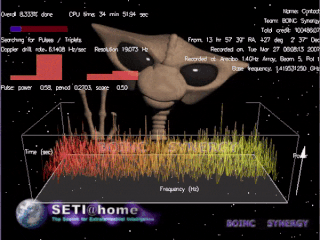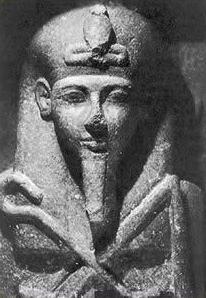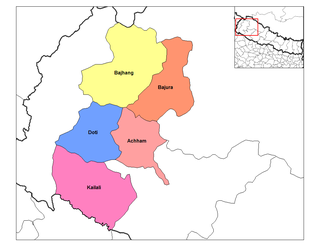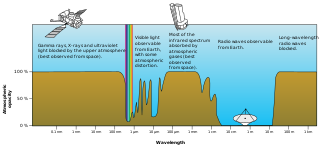Related Research Articles

The search for extraterrestrial intelligence (SETI) is a collective term for scientific searches for intelligent extraterrestrial life, for example, monitoring electromagnetic radiation for signs of transmissions from civilizations on other planets.

Frank Donald Drake was an American astrophysicist and astrobiologist.

Menmaatre Seti I was the second pharaoh of the Nineteenth Dynasty of Egypt during the New Kingdom period, ruling c.1294 or 1290 BC to 1279 BC. He was the son of Ramesses I and Sitre, and the father of Ramesses II.

SETI@home is a project of the Berkeley SETI Research Center to analyze radio signals, searching for signs of extraterrestrial intelligence. Until March 2020, it was run as an Internet-based public volunteer computing project that employed the BOINC software platform. It is hosted by the Space Sciences Laboratory at the University of California, Berkeley, and is one of many activities undertaken as part of the worldwide SETI effort.

Menpehtyre Ramesses I was the founding pharaoh of ancient Egypt's 19th Dynasty. The dates for his short reign are not completely known but the time-line of late 1292–1290 BC is frequently cited as well as 1295–1294 BC. While Ramesses I was the founder of the 19th Dynasty, his brief reign mainly serves to mark the transition between the reign of Horemheb, who had stabilized Egypt in the late 18th Dynasty, and the rule of the powerful pharaohs of his own dynasty, in particular his son Seti I, and grandson Ramesses II.

The SETI Institute is a not-for-profit research organization incorporated in 1984 whose mission is to explore, understand, and explain the origin and nature of life in the universe, and to use this knowledge to inspire and guide present and future generations, sharing knowledge with the public, the press, and the government. SETI stands for the "search for extraterrestrial intelligence".

Seti II was the fifth pharaoh of the Nineteenth Dynasty of Egypt and reigned from c. 1203 BC to 1197 BC. His throne name, Userkheperure Setepenre, means "Powerful are the manifestations of Re, the chosen one of Re." He was the son of Merneptah and Isetnofret II and sat on the throne during a period known for dynastic intrigue and short reigns, and his rule was no different. Seti II had to deal with many serious plots, most significantly the accession of a rival king named Amenmesse, possibly a half brother, who seized control over Thebes and Nubia in Upper Egypt during his second to fourth regnal years.

Amenmesse was the fifth pharaoh of the Nineteenth Dynasty in Ancient Egypt, possibly the son of Merneptah and Queen Takhat. Others consider him to be one of the innumerable sons of Ramesses II. Very little is known about this pharaoh, who ruled Egypt for only three to four years. Various Egyptologists date his reign between 1202 BC–1199 BC or 1203 BC–1200 BC with others giving an accession date of 1200 BC. Amenmesse means "born of or fashioned by Amun" in Egyptian. Additionally, his nomen can be found with the epithet Heqa-waset, which means "Ruler of Thebes". His royal name was Menmire Setepenre.
Bernard M. Oliver, also known as Barney Oliver, was a scientist who made contributions in many fields, including radar, television, and computers. He was the founder and director of Hewlett Packard (HP) laboratories until his retirement in 1981. He is also a recognized pioneer in the search for extraterrestrial intelligence (SETI). Oliver was president of the Institute of Electrical and Electronics Engineers in 1965. In 1986, Oliver was a National Medal of Science recipient for Engineering Science and on February 11, 2004 it was announced that Oliver had been inducted into the National Inventors Hall of Fame.
Project Cyclops is a 1971 NASA project that investigated how SETI should be conducted. As a NASA product the report is in the public domain. The project team created a design for coordinating large numbers of radio telescopes to search for Earth-like radio signals at a distance of up to 1,000 light-years to find intelligent life. The proposed design was shelved due to costs. However, the report became the basis for much of the SETI work to follow.

The Allen Telescope Array (ATA), formerly known as the One Hectare Telescope (1hT), is a radio telescope array dedicated to astronomical observations and a simultaneous search for extraterrestrial intelligence (SETI). The array is situated at the Hat Creek Radio Observatory in Shasta County, 290 miles (470 km) northeast of San Francisco, California.

Akhenre Setepenre Siptah or Merenptah Siptah was the penultimate ruler of the Nineteenth Dynasty of Egypt. His father's identity is currently unknown. Both Seti II and Amenmesse have been suggested although the fact that Siptah later changed his royal name or nomen to Merneptah Siptah after his Year 2 suggests rather that his father was Merneptah. If correct, this would make Siptah and Seti II half-brothers since both of them were sons of Merneptah.

Seti was one of the fourteen zones located in the Far-Western Development Region of Nepal. Dhangadhi in the Terai is the major city of Seti Zone; headquarters are in Dipayal-Silgadhi. As of 2015, Nepal discontinued zone designations in favor of provinces; the area previously known as Seti Zone is now part of Sudurpashchim Province.

Takhat was an ancient Egyptian princess and queen of the 19th Dynasty, the mother of the usurper pharaoh Amenmesse.

The waterhole, or water hole, is an especially quiet band of the electromagnetic spectrum between 1420 and 1662 megahertz, corresponding to wavelengths of 21 and 18 centimeters, respectively. It is a popular observing frequency used by radio telescopes in radio astronomy.
Active SETI is the attempt to send messages to intelligent extraterrestrial life. Active SETI messages are predominantly sent in the form of radio signals. Physical messages like that of the Pioneer plaque may also be considered an active SETI message. Active SETI is also known as METI. The term METI was coined by Russian scientist Alexander Zaitsev, who proposed a subtle distinction between Active SETI and METI:
The science known as SETI deals with searching for messages from aliens. METI deals with the creation and transmission of messages to aliens. Thus, SETI and METI proponents have quite different perspectives. SETI scientists are in a position to address only the local question “does Active SETI make sense?” In other words, would it be reasonable, for SETI success, to transmit with the object of attracting ETI’s attention? In contrast to Active SETI, METI pursues not a local, but a more global purpose – to overcome the Great Silence in the Universe, bringing to our extraterrestrial neighbors the long-expected annunciation “You are not alone!”
setiQuest is an inactive project of the SETI Institute, whose declared aim is to "globalize the search for extra-terrestrial intelligence and empower a new generation of SETI enthusiasts", by creating means for a deeper involvement from the interested public. The project focuses on amplifying the human potential of SETI enthusiasts, and consists of four main fronts: Software, DSP Algorithms, Citizen Scientists, and Data release. Although there is no present activity on setiQuest per-se, much of the code and raw data products are still available on its successor site.

The Nineteenth Dynasty of Egypt, also known as the Ramessid dynasty, is classified as the second Dynasty of the Ancient Egyptian New Kingdom period, lasting from 1292 BC to 1189 BC. The 19th Dynasty and the 20th Dynasty furthermore together constitute an era known as the Ramesside period. This Dynasty was founded by Vizier Ramesses I, whom Pharaoh Horemheb chose as his successor to the throne.

HD 164595 is a G-type star located in the constellation of Hercules, 28.28 parsecs from Earth that is notably similar to the Sun. With an apparent magnitude of 7.075, the star can be found with binoculars or a small telescope in the constellation Hercules.

The Berkeley SETI Research Center (BSRC) conducts experiments searching for optical and electromagnetic transmissions from intelligent extraterrestrial civilizations. The center is based at the University of California, Berkeley.
References
- ↑ Seti at Ethnologue (18th ed., 2015) (subscription required)